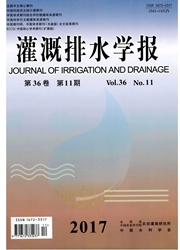

 中文摘要:
中文摘要:
基于SWAT模型建立了适用于漳河灌区杨树垱小流域水量平衡和面源污染模拟分布式水文模型,利用模型模拟分析了未来气候变化对灌区氮负荷排放的影响,以及增加塘堰汇流面积对未来气候变化下氮负荷的调控作用。结果表明,未来气候情景下,灌区氮负荷排放量明显增加;增加塘堰汇流面积,灌区产流量减少,并且氮负荷排放量能与现状条件下的持平甚至减少。增加塘堰汇流面积是未来气候情景下提高灌区水肥利用效率,削减氮污染排放的有效措施;为使总氮排放负荷不增加,未来气候情景下研究区塘堰汇流面积的合理增幅为30%。
 英文摘要:
英文摘要:
A distributed hydrological model based on SWAT2009 was constructed for Yangshudang basin in Zhanghe Irrigation Area. The model was used to simulate the water balance and non-point source pollution, and the impacts of future climate change on the nitrogen discharge in this region. Furthermore, the regulatory effect on nitrogen discharge was simulated by increasing the pond area in this region. The results showed that the nitro- gen discharge in this region was significantly increased under the future climate scenarios. Whereas, by increas- ing the pond area in this region under the future climate scenarios, the runoff could be greatly cut down, and the nitrogen discharge could be kept as the same to present situation or even less. By increasing the pond area in the irrigation area would be a valid way to control the nitrogen discharge under future climate scenarios. According to the decreasing rate of the nitrogen discharge from paddy rice field or basin outlet under the future climate sce- narios by increasing the pond area, in order to ensure the nitrogen discharge same to present, increasing the pond area by 30% would be reasonable for Zhanghe Irrigation Area.
 同期刊论文项目
同期刊论文项目
 同项目期刊论文
同项目期刊论文
 期刊信息
期刊信息
